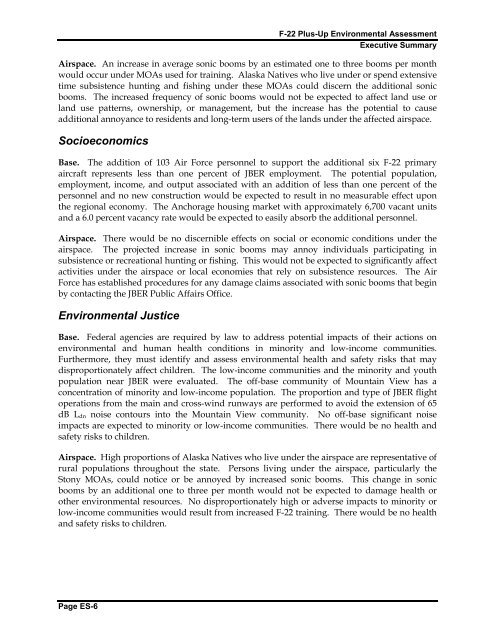F-22 Plus-Up Environmental Assessment - Joint Base Elmendorf ...
F-22 Plus-Up Environmental Assessment - Joint Base Elmendorf ...
F-22 Plus-Up Environmental Assessment - Joint Base Elmendorf ...
You also want an ePaper? Increase the reach of your titles
YUMPU automatically turns print PDFs into web optimized ePapers that Google loves.
F-<strong>22</strong> <strong>Plus</strong>-<strong>Up</strong> <strong>Environmental</strong> <strong>Assessment</strong><br />
Executive Summary<br />
Airspace. An increase in average sonic booms by an estimated one to three booms per month<br />
would occur under MOAs used for training. Alaska Natives who live under or spend extensive<br />
time subsistence hunting and fishing under these MOAs could discern the additional sonic<br />
booms. The increased frequency of sonic booms would not be expected to affect land use or<br />
land use patterns, ownership, or management, but the increase has the potential to cause<br />
additional annoyance to residents and long-term users of the lands under the affected airspace.<br />
Socioeconomics<br />
<strong>Base</strong>. The addition of 103 Air Force personnel to support the additional six F-<strong>22</strong> primary<br />
aircraft represents less than one percent of JBER employment. The potential population,<br />
employment, income, and output associated with an addition of less than one percent of the<br />
personnel and no new construction would be expected to result in no measurable effect upon<br />
the regional economy. The Anchorage housing market with approximately 6,700 vacant units<br />
and a 6.0 percent vacancy rate would be expected to easily absorb the additional personnel.<br />
Airspace. There would be no discernible effects on social or economic conditions under the<br />
airspace. The projected increase in sonic booms may annoy individuals participating in<br />
subsistence or recreational hunting or fishing. This would not be expected to significantly affect<br />
activities under the airspace or local economies that rely on subsistence resources. The Air<br />
Force has established procedures for any damage claims associated with sonic booms that begin<br />
by contacting the JBER Public Affairs Office.<br />
<strong>Environmental</strong> Justice<br />
<strong>Base</strong>. Federal agencies are required by law to address potential impacts of their actions on<br />
environmental and human health conditions in minority and low-income communities.<br />
Furthermore, they must identify and assess environmental health and safety risks that may<br />
disproportionately affect children. The low-income communities and the minority and youth<br />
population near JBER were evaluated. The off-base community of Mountain View has a<br />
concentration of minority and low-income population. The proportion and type of JBER flight<br />
operations from the main and cross-wind runways are performed to avoid the extension of 65<br />
dB L dn noise contours into the Mountain View community. No off-base significant noise<br />
impacts are expected to minority or low-income communities. There would be no health and<br />
safety risks to children.<br />
Airspace. High proportions of Alaska Natives who live under the airspace are representative of<br />
rural populations throughout the state. Persons living under the airspace, particularly the<br />
Stony MOAs, could notice or be annoyed by increased sonic booms. This change in sonic<br />
booms by an additional one to three per month would not be expected to damage health or<br />
other environmental resources. No disproportionately high or adverse impacts to minority or<br />
low-income communities would result from increased F-<strong>22</strong> training. There would be no health<br />
and safety risks to children.<br />
Page ES-6
















